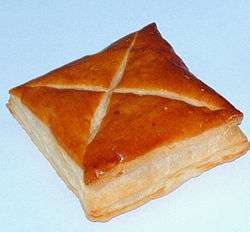Spanisch Brötli
 | |
| Alternative names | Spanisch Brödli, Spanischbrötli, Spanischbrödli |
|---|---|
| Type | Pastry |
| Course | Dessert / snack |
| Place of origin | Switzerland |
| Region or state | Baden |
| Creator | Spanish traditional food |
| Serving temperature | At room temperature or just after cooling |
| Main ingredients | Flour, hazelnuts, apricot jam |
|
| |
Spanisch Brötli (English: "Spanish bun", also known as Spanisch Brödli, Spanischbrötli or Spanischbrödli) is a speciality pastry from Baden, Switzerland.
It is a light, flaky pastry filled with a mix of roasted, crushed hazelnuts and apricot jam. Its structure has a square of dough for the lower portion, apricot and hazelnut filling for the middle portion, and a square of dough for the upper portion. It has an "X" (or "cross") cut into the top to allow for the food to vent hot air during baking.
History
Spanisch Brötli were first mentioned in a 1701 book by Samuel Hottinger about the city and baths of Baden. Brötli were very popular among wealthy people of Zürich, so their servants had to go 25 km to Baden by foot in the night to be able to buy brötli very early in the morning and to bring them back to the breakfast.
When in 1847 the Swiss Northern Railway, the first railway line in Switzerland, was opened, connecting Zürich and Baden. This allowed Spanisch Brötli to be brought to Zürich in just 45 minutes. Because of that usage of the line it's been called Spanisch-Brötli-Bahn since those times.
During the 20th century these pastries fell out of favour and were almost forgotten until local bakeries revived the recipe in 2007, creating some new variants. Nowadays the pastry is sold under a trademark Spanischbrödli.
See also
- Brotli, the open-source data-compression library
- Culinary Heritage of Switzerland
External links
- Spanischbrötli's entry in the Database of Culinary Heritage of Switzerland (Der Datenbank von Kulinarisches Erbe der Schweiz)
- Lamiacucina's article on Spanisch Brötli featuring photographs